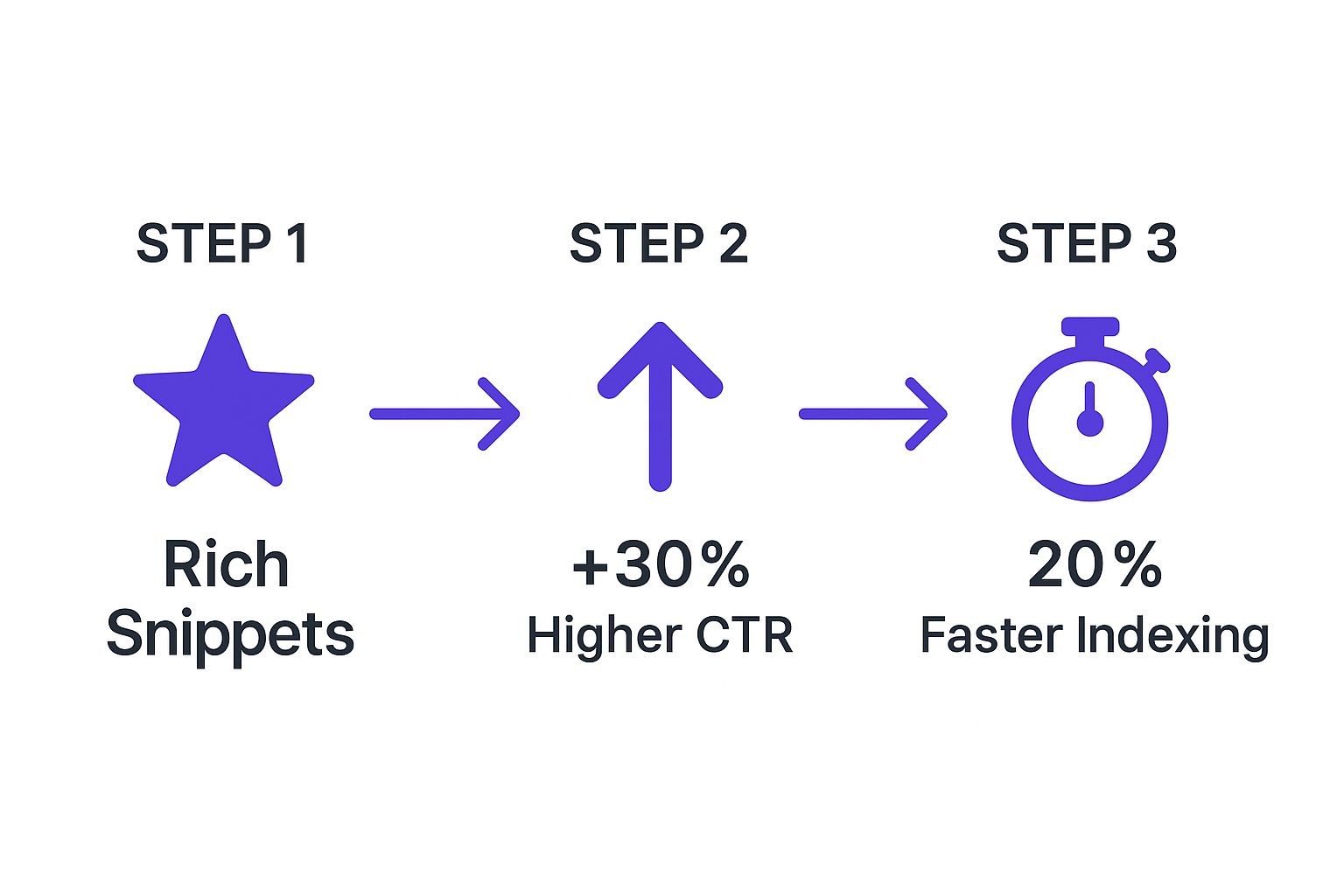At its core, structured data is like a secret translator for search engines. It’s a special bit of code you add to your website that labels and organizes your content, telling Google exactly what it’s looking at - is this a blog post, a product for sale, or an upcoming event?
This simple act of organization is what helps your pages really pop in search results.
Translating Your Website for Search Engines
Imagine your website is a fascinating book. Search engines like Google can read the words and get the gist of what it's about, but they often miss the deeper context and the relationships between all the different pieces of information.
This is where structured data comes in. It doesn't change a single thing your visitors see on the page. Instead, it works behind the scenes, adding a layer of invisible labels - often called markup - that speaks directly to search engines in their native language.
Think of it like adding detailed footnotes to your book that explain key concepts. You can use it to tell Google things like:
- "Hey, this string of numbers? That's the price of the product."
- "This is the name of the author for this article."
- "This specific date and time? That's the start of our next webinar."
- "And these five stars? That's a user-submitted rating."
The Power of Clear Communication
Without these labels, a search engine is left to guess. With them, you remove all the guesswork. This crystal-clear communication is a game-changer because it allows search engines to do more than just list your page; they can actually understand it well enough to show it off in much more interesting and helpful ways.
To give you a clearer picture, let's compare how a search engine "sees" a page with and without this special markup.
How Search Engines See Your Content
| Feature | Without Structured Data (A Block Of Text) | With Structured Data (A Labeled Recipe) |
|---|---|---|
| Content Interpretation | "This page has words like 'flour,' 'sugar,' 'bake,' and a number '45.' It's probably a recipe." | "This is a Recipe. The cook time is 45 minutes. It has an average rating of 4.8 stars." |
| Search Result Display | Shows a standard blue link with a title and a short description. | Can show up as a "rich result" with star ratings, an image, and cook time right on the search page. |
| Contextual Understanding | The search engine has to infer the meaning of different elements. | Every key piece of information is explicitly defined and understood. |
See the difference? One is a guess, and the other is a guarantee.
This ability to guarantee understanding is what unlocks those enhanced listings known as rich results. You've definitely seen them - they're the search results with star ratings, event schedules, or FAQ dropdowns right there on the search page.
Structured data has become a massive part of modern SEO for this very reason. It’s not a niche trick anymore; according to one study highlighted by Search Engine Land, over 45 million domains worldwide are using schema markup. That's a huge number, and it shows just how critical it is to give search engines that explicit context if you want to earn those valuable, eye-catching spots.
By neatly organizing your site's information, you’re not just tidying up your technical SEO. You’re building a much better, more informative experience for users before they even click through to your site. This same principle of clear organization is just as vital for your most important pages, which we dive into in our guide on landing page SEO tips.
So, Why Is Structured Data Such a Big Deal for SEO?
Okay, we've established that structured data is basically a translator for search engines. But why should you care? The single biggest reason is its power to unlock rich results - those beefed-up, eye-catching listings that pop on a crowded search page.
You've definitely seen them. They're the results showing star ratings, product prices, event dates, or even little thumbnail images right there in the search listing. They don't just look prettier; they give the searcher a ton of value before they even click.
This visual upgrade has a real, measurable impact. By taking up more space and offering instant answers, rich results can seriously boost your click-through rate (CTR). And a higher CTR is a massive signal to Google that your page is exactly what people are looking for.
Going Way Beyond the Standard Blue Link
Think about it. You’re searching for a local concert. One result is the same old blue link and a snippet of text. The one right below it, however, shows the event date, time, and venue. Which one are you clicking?
The second one, every time. It’s more helpful and feels more legitimate right off the bat. That’s the magic of structured data: it turns a generic listing into a compelling preview of what’s on your page.
Simply put, structured data transforms your search result into a mini-advertisement for your page. It hands users a great reason to pick your link over all the others by showing them the good stuff upfront.
Powering the Future of How We Search
But the perks don't end with rich results. Structured data is the engine behind a ton of other advanced search features that can put your brand in the spotlight.
- Google's Knowledge Graph: It’s how Google understands that your logo, address, and official website all belong to your company. This info then gets pulled into that big, prominent Knowledge Panel on the right side of the search results.
- Voice Search Answers: Ever ask a smart speaker a question? More often than not, it’s pulling its answer directly from a page that uses structured data. This markup helps assistants like Google Assistant or Siri find and read out specific info in a snap.
- Enhanced Image Search: For things like products or recipes, structured data can add little badges to your images in Google Images, showing off details like price, if it's in stock, or customer ratings.
When you add structured data to your site, you’re doing more than just optimizing for today. You’re future-proofing your content. You’re making sure search engines and AI assistants can understand and feature your information, no matter how people are searching. This is a core part of any solid what is structured data in SEO strategy.
Putting Schema Markup Into Practice
Alright, let's get practical. To implement structured data, you can't just make up your own tags. Everyone needs to agree on the same language, and that's where Schema.org comes in.
Think of it as a massive, shared dictionary built by Google, Microsoft, and Yahoo!. It provides a standardized vocabulary - a huge catalog of predefined labels - that you can attach to your content.
By using these universally understood labels, you’re basically whispering directly into the search engine's ear, telling it exactly what everything on your page means. That clarity is the first, crucial step to unlocking those fancy rich results we all want.
The Most Valuable Schema Types
While there are hundreds of different schema types, you don't need to know them all. Most businesses can see a huge SEO boost by focusing on just a handful of the most powerful ones.
Each type is designed for a specific purpose, helping search engines understand a different piece of your digital puzzle.
Here are a few of the essentials you should know about:
- Organization Schema: This is your digital business card for search engines. It clearly states your company’s official name, logo, contact details, and social profiles. It's foundational for getting your brand into Google's Knowledge Graph.
- LocalBusiness Schema: An absolute must if you have a physical location. This schema spells out your address, hours, and phone number, which is critical for showing up in local search and on maps when people are looking for you.
- Article Schema: If you run a blog or a news site, this is for you. It flags your content as an article, highlighting the headline, author, and publish date. It's your ticket to appearing in things like news carousels.
- Product Schema: For any e-commerce store, this is non-negotiable. It lets you show off product prices, availability, and even star ratings right there in the search results. Talk about a compelling pitch before they even click.
- FAQ Schema: This little gem turns your FAQ page into an interactive dropdown menu in the search results. Users get instant answers to their questions, which makes you look incredibly helpful and saves them a click.
Despite how powerful this stuff is, it’s shocking how many sites aren’t using it properly. While many have basic social media tags, they miss out on the deeper SEO value. In fact, research shows over 23% of websites still don't use any structured data at all, leaving a wide-open opportunity for those who do.
Highlighting Events With Event Schema
Now, for any business that runs events - whether they're webinars, conferences, or even flash sales - the Event schema is a game-changer.
This specific markup lets you feed search engines all the critical details: the event name, date, time, location, and more.
When you get it right, Google can use this information to create a rich result that puts your event front and center. This kind of visibility makes it ridiculously easy for people to find and sign up for what you're hosting.
The catch? Generating and maintaining valid Event schema can be a real headache, especially if you're not a developer. That's precisely why our service, Add to Calendar PRO, handles it all for you automatically.
When you create an event page with our tool, it generates the perfect Event schema markup behind the scenes. Your events get optimized for search without you ever having to look at a single line of code. To see exactly how we do it, check out our complete guide to Event Schema Markup.
A Practical Guide To Implementing Structured Data
Structured data often sounds overwhelming, but you don’t need to be a developer to get started. This walkthrough breaks each stage into bite-sized pieces, so search engines can read your content without any fuss.
Search engines recognize metadata in three main formats:
- Microdata: Tags embedded directly within your HTML.
- RDFa: Semantic attributes sprinkled through your markup.
- JSON-LD: A standalone script block that lives apart from the page code.
Google has adopted JSON-LD as its go-to format. By keeping all metadata in one script tag, it minimizes the chance of accidentally breaking your page. For more on how JSON-LD rules the schema world, check out the latest schema statistics.
A Simple Three-Step Workflow
Getting structured data live on your site only takes three clear steps:
- Choose the Right Schema Type
• Article schema for blog posts
• Product schema for sales pages
• Event schema for your upcoming webinars or conferences - Generate Your Markup
Use Google’s Structured Data Markup Helper to tag on-page elements. It spits out clean JSON-LD you can copy and paste. - Test and Validate Your Code
A stray comma can spoil everything. Run your snippet through Google’s Rich Results Test to spot any errors before you publish.
Here’s what the validation looks like in action:

This free tool shows if your page is eligible for rich results and flags any markup issues.
Automating The Process For Maximum Impact
Manually tagging every page makes one-off posts easier, but automation scales across dozens or hundreds of pages. Platforms like Add to Calendar PRO automatically insert the correct Event schema whenever you publish an event page.
That means rich snippets, better click-through rates, and faster indexing - without writing a single line of code. For tips on building a winning event landing page, see our in-depth walkthrough.

As this visual shows, properly applied structured data unlocks eye-catching rich snippets, drives more clicks, and ensures search engines pick up your content quickly. Once it’s set up, you’ll spend less time fixing markup and more time refining your message.
Common Structured Data Mistakes To Avoid

Putting structured data on your site is a huge step forward for your SEO. But it’s surprisingly easy to trip at the finish line. Even a single misplaced comma or bracket can break your entire code, making it completely useless to search engines.
Think of it like giving someone GPS coordinates with one digit off - you simply won't end up where you wanted to go. These tiny syntax errors are incredibly common, which is why validating your code is a non-negotiable step. Always run it through a tool like Google's Rich Results Test before you publish.
But it’s not just about typos. There are a few other subtle but critical mistakes that can stop your pages from earning those valuable rich results. Let's walk through the most common pitfalls so you can steer clear of them.
Mismatched Schema and Content
One of the most frequent errors we see is people applying the wrong type of schema to their content. This is like trying to fit a square peg in a round hole. You wouldn't use Product schema on a blog post or Article schema on your homepage, right? It just confuses things for search engines.
The rule is simple: the structured data you add must accurately reflect the main content of the page. If your page is about an upcoming webinar, you absolutely must use
Eventschema, not something more generic.
A mismatch like this sends completely conflicting signals to Google. Instead of clarifying what your page is about, it muddies the waters and virtually guarantees you won't get the rich result you were hoping for. Always pick the most specific and relevant schema type you can find.
Incomplete or Missing Properties
Every schema type comes with a set of "required" and "recommended" properties. Leaving out the required information is a surefire way to invalidate your entire markup.
For example, Event schema is pretty useless without the core details. You absolutely have to include:
- The name of the event (
name) - A valid start date and time (
startDate) - The event's location (
location)
If you leave out startDate, the markup is invalid because an event without a date isn't really an event. While the "recommended" properties aren't strictly mandatory, filling them out provides much richer context to search engines and seriously boosts your chances of standing out.
Marking Up Hidden Content
This one is a big no-no. A critical mistake is marking up information that isn't actually visible to a human visitor on the page. This is a direct violation of Google's guidelines and can even get you a manual action penalty.
If you add a five-star rating in your structured data, that exact rating must be clearly visible on the page for your users to see. The same goes for event dates, prices, or author names. The whole point of structured data is to label what’s already there, not to sneak in information that only search engines can see.
Always ensure your markup matches the user-visible content. It’s about transparency, both for your visitors and for Google.
Your Structured Data Questions Answered
Even after getting the basics down, a few questions about structured data always seem to pop up. Let's tackle the most common ones so you can move forward with confidence.
This isn't about memorizing code. It's about understanding what really happens when you make your website's content crystal clear to search engines. Think of this as the final piece of the puzzle, connecting the dots between theory and real-world results.
Getting these fundamentals right is what makes all the effort pay off with better visibility.
Does Structured Data Directly Improve Search Rankings?
This is the million-dollar question, and the answer isn't a simple yes or no. While structured data is not a direct ranking factor - meaning it won't push you up the list like a great backlink - it gives your SEO a powerful, indirect boost. Its main job is to make your page eligible for rich results.
Those rich results, like star ratings, event dates, or FAQ dropdowns, are impossible to ignore on a search results page. They take up more screen real estate and offer answers at a glance, which almost always leads to a much higher click-through rate (CTR). A better CTR sends a strong signal to Google that users find your result more valuable, and that can absolutely influence your rankings over time.
Think of it this way: structured data doesn't directly move you up the ladder, but it makes your rung on the ladder the biggest, shiniest, and most compelling one to click on.
How Long Until Rich Results Appear After Adding Schema?
Patience is a virtue here. Once you've implemented structured data, there’s no official countdown clock for when rich results will appear. It could be a few days or even several weeks, and it’s all up to Google's crawling and indexing schedule.
If you want to give Google a little nudge, you can submit your updated URL through the "URL Inspection" tool in Google Search Console. This is like raising your hand and telling Google you've made changes and would love for them to take a look.
But even with a flawless implementation, Google does not guarantee that rich results will show up. Their appearance is an automated decision based on things like the specific search query, the user's location and device, and your site's overall authority. Your job is to make your page eligible; Google makes the final call.
Should I Use JSON-LD or Microdata?
For almost every scenario you'll encounter today, JSON-LD (JavaScript Object Notation for Linked Data) is the way to go. It's the format Google officially recommends, and for very good reasons.
JSON-LD is implemented as a single, self-contained script that you can drop into the <head> or <body> of your HTML. This separation makes it incredibly easy to manage and update without ever having to mess with the content your visitors see.
Here’s a quick breakdown:
- JSON-LD: A neat little block of code that describes the page's content. It’s clean, self-contained, and keeps your structured data separate from your core HTML, which drastically reduces the risk of breaking things.
- Microdata: This method involves weaving tags and properties directly into your existing HTML elements. It can quickly become a tangled mess that’s a nightmare to maintain, especially when you want to redesign your site.
For simplicity, flexibility, and sanity-saving maintenance, always go with JSON-LD. It’s the modern standard and ensures your markup is both effective and manageable.
Ready to harness the power of Event Schema without the hassle? Add to Calendar PRO automatically generates perfectly structured, SEO-optimized event pages to get your events noticed by search engines. Learn more and get started today at add-to-calendar-pro.com.



